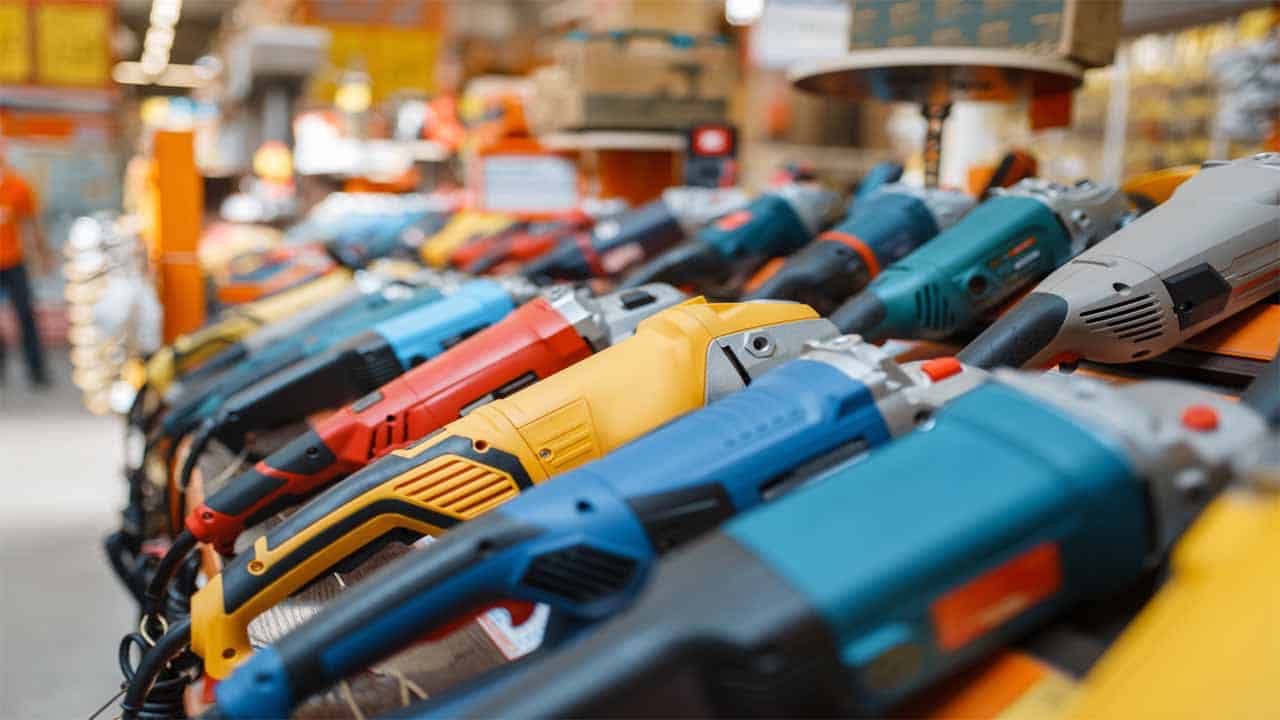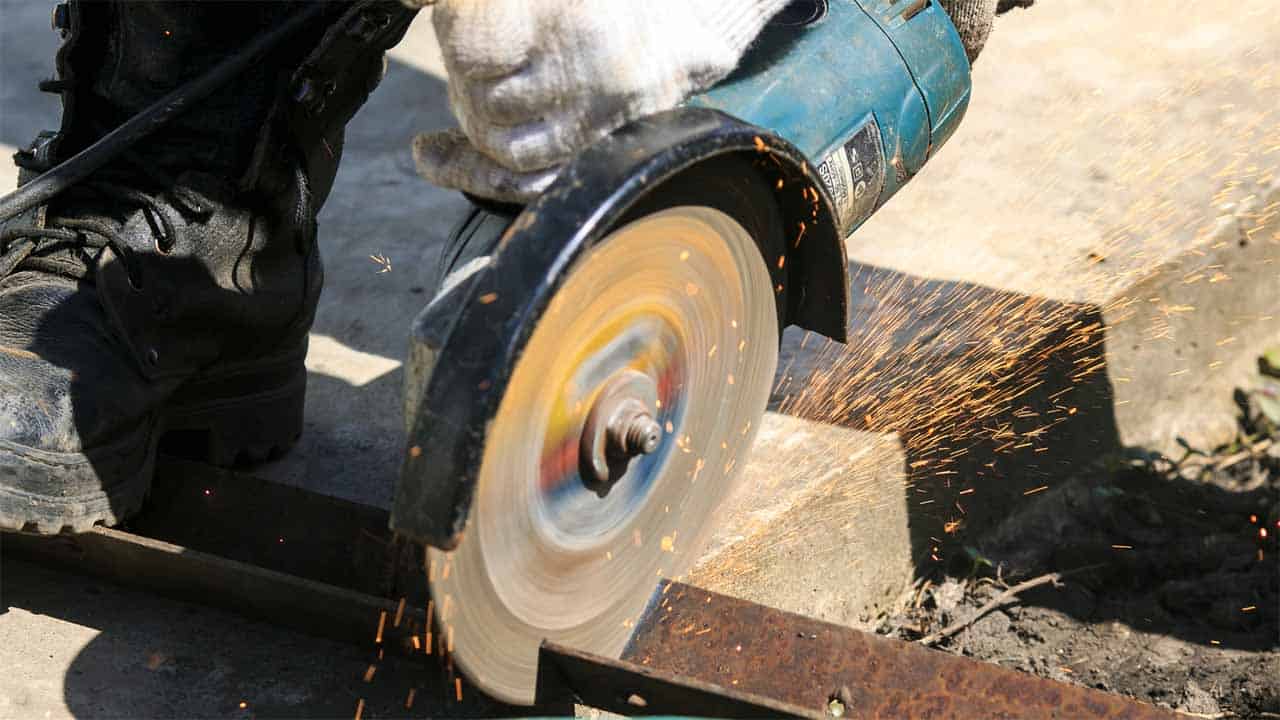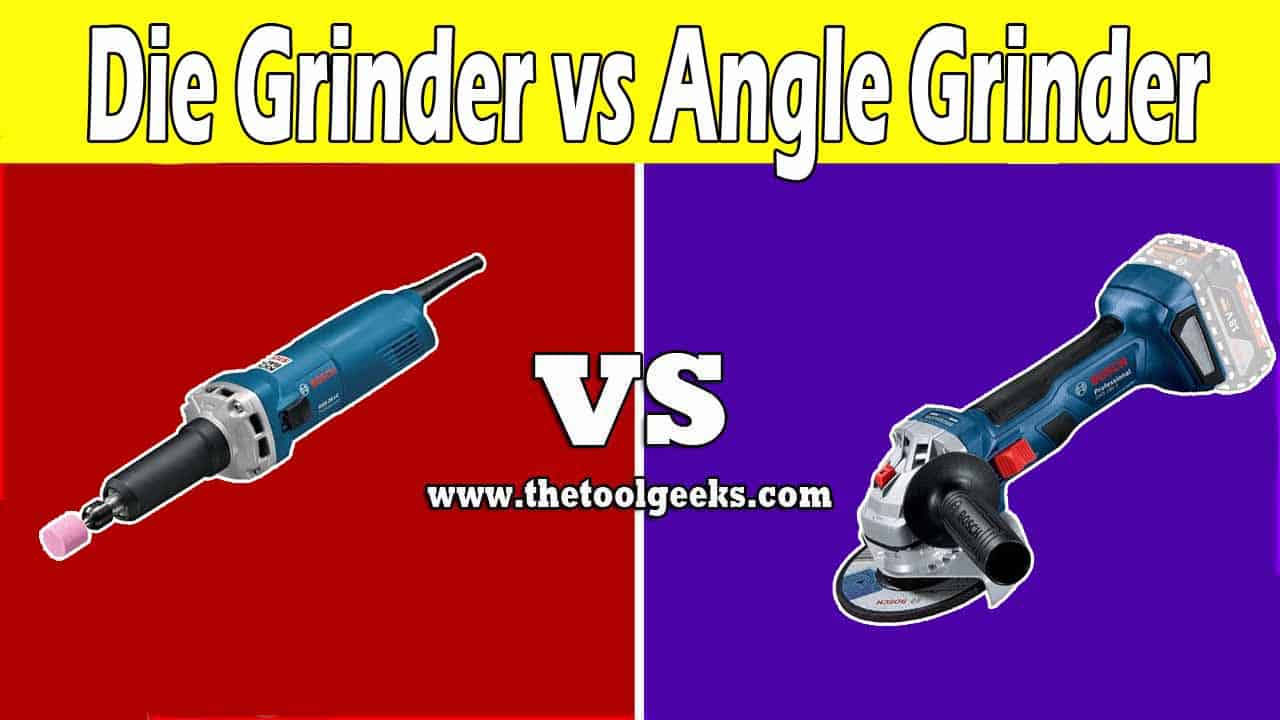Die Grinder vs Angle Grinder (5 Differences Explained)
TheToolGeeks.com is a participant in the Amazon Services LLC Associates Program and other affiliate advertising programs. We may earn from qualifying purchases. (Learn More).
Grinders are versatile power tools that cut across both worlds of carpentry and steelwork. Grinders are used for different tasks. You can use grinders to cut materials, grind, sharpen, and sand. It all depends on what task you have in mind.
But, just like all other power tools that have several types, there are different types of grinders too. Each grinder with its unique build and function.
Though there are several types of grinders, two grinders are usually on the top of every prospective buyer’s list. These are the Die grinder and the Angle grinder.
Both grinders work brilliantly and they can both execute several tasks when attached with the right parts. But, what are the differences between the die grinder vs angle grinder, and which do you need for your task? Let’s find out.
First, let’s check out Die grinders.
Jump To Page Contents:
What Is a Die Grinder and What Is It Used for?
Die grinders are small handheld grinders that can be used to polish, sand, cut, sharpen, and grind different surfaces and instruments. Die grinders are lightweight with the common models weighing less than 3 pounds.

Most die grinders come with components or parts called bits. For those that aren’t designed with bits, the bit needed will be purchased separately. Bits are used to describe the different attachments that can be used with the die grinder.
There are sanding bits for sanding rough surfaces and removing materials from wood and steel. There are polishing bits for polishing surfaces. There are cutting bits used to cut different materials ranging from wood to metal and so on. For each task you want to complete with a die grinder, there is a bit that can be attached to the tip of the die grinder to complete the task.
Die grinders due to their small size and lightweight are great with tight spaces. The grinder can be used to sand, cut, or polish tight spaces and difficult to reach areas in the home.
Die grinders are popular for sanding and cutting but the tool isn’t just restricted to that. With the right bit, you can sand, cut, polish, and do a whole lot more with a die grinder. This makes die grinders a very versatile power tool to have. It doesn’t come as a surprise that the die grinder’s main strength is its versatility.
The main downside of the die grinder is that it isn’t a powerful tool. The motors of most die grinders do not go beyond 5amps in the power rating. Die grinders can’t tackle large tasks.
They are more suited for small tasks or small surfaces that don’t require much work. Die grinders are great for small surfaces like shelves, stools, and the likes. Now let’s check out angle grinders.
Related Read — Best Die GrindersWhat Is an Angle Grinder and What Is It Used for?
Angle grinders are always the first name that comes to mind when you hear of grinders. This is because angle grinders are very common and there is a chance you might have come across one or even used one.

Angle grinders are also called disc sanders or disc grinders. This is because of the saw’s spinning disc that is used for sanding and polishing. The disc of the angle grinder is often about 5 inches in diameter and it can be made from different materials. Angle grinders are popular for sanding and polishing metal and wooden surfaces.
Angle grinders are a bit larger than die grinders. An angle grinder on average weighs about 10 pounds with some other models weighing up to 15 pounds. Angle grinders or disc sanders come in both corded and battery-powered models. Most users prefer to go for the battery-powered models because it gives a higher level of mobility.
Unlike die grinders, angle grinders are powerful tools that are used majorly for rough work. Angle grinders have motors that are capable of generating speeds of up to 10,000 RPM (revolutions per minute). This sounds a bit much but when you find out that the power tool is usually powered by a 7 amp motor, you wouldn’t be that surprised.
Angle grinders can also be used for different tasks. You can sand, polish, cut, and sharpen surfaces and materials with an angle grinder. The major difference is that instead of the bits used by die grinders, angle grinders use discs. There are sanding discs that come in different grits, polishing discs, cutting discs, and even diamond discs that are used for cutting tough materials like masonry.
As long as you attach the right disc to the angle grinder, you can complete several tasks. The main advantage of the angle grinder is its power. This means it is more suited to large-scale tasks.
The main downside to the angle grinder is that it is slightly heavier and the large size means it can’t fit into tight corners and spaces. Asides from that, it’s a pretty good power tool to have. But how good is it when compared to the die grinder? Let’s find out.
Related Read — Best Angle GrindersDie Grinder vs Angle Grinder (Head to Head)
The angle grinder and die grinder are both terrific tools. They are both handheld grinders that can tackle several needs and different types of tasks.
However, if you want to buy one, it’s always a good idea to know where each grinder stands when compared to the other.
This will help you figure out which grinder you need for your task and which you should buy. So, let’s do a vivid comparison using both grinders’ features.
The Power
The power of a grinder determines the type of task the grinder can take on and the type of material it can work on. Both the angle grinder and die grinder are powerful tools. However, the angle grinder is more powerful than the die grinder.
The power of the grinder is determined by the motor. Angle grinders usually have a more powerful motor than die grinders. The amperage (amps) of an angle grinder’s motor ranges between 5 amps and 15 amps depending on the size of the angle grinder.
The smaller 4½ inch angle grinders have motors as powerful as 5 or 6 amps depending on the model you buy. The bigger 7-inch angle grinders have motors as powerful as 13 to 15 amps.
Die grinders on the other hand usually have motors as powerful as 5 amps or less. The increased power of the angle grinder means the power tool can take on large-scale tasks while the die grinder is more suited to smaller tasks. Angle grinders can sand or polish large surfaces like tabletops and countertops while die grinders are more suited to smaller surfaces like furniture.
Related Read — Best Battery Angle GrindersThe Speed
The speed of the grinder also matters when performing tasks. For instance, while cutting, a greater speed means you can cut materials faster and also arrive at a smooth cut.
In terms of speed, die grinders are faster than angle grinders. This might pose a bit of confusion since angle grinders have more powerful motors. The idea is bigger motors or powerful motors generate less speed because they mostly power heavier discs or bits.
The speed of an angle grinder ranges between 6000 RPM for the heavier models like the 7-inch angle grinders to about 12000 RPM on the lighter models like the 4½ inch angle grinders. Die grinders on the other hand are faster since the bits are lighter.
Lighter bits mean the motor can spin the bit even faster. Generally, die grinders range between 8000 RPM for the larger models and 34000 RPM for the light models. That’s an average of about 20000 RPM. That’s twice the speed of the regular angle grinder.
This doesn’t however mean that angle grinders are slower. It just means die grinders are faster than angle grinders. Angle grinders are still fast enough to cut different materials including masonry and tiles.
The Size and Weight
The size and weight of the grinder determine how easy it will be to maneuver the grinder across a surface. In terms of size, angle grinders are larger than die grinders. The size of both grinders is measured in length because both grinders are about the same size in width.
The smaller 4½ inch angle grinder ranges between 8 and 15 inches in length. On average, the smaller 4½ inch angle grinder is about 12 inches long. The larger models like the 7-inch angle grinder range between 18 and 25 inches in length. On average, the 7-inch angle grinder is about 22 inches in length.
Die grinders on the other hand are smaller. At best, a large die grinder will be about 20 inches long. The smaller models are usually about 7 or 8 inches long at best. When you compare this size to that of the angle grinders, you can see that angle grinders are bigger.
In terms of the weight, angle grinders also weigh more than die grinders though this shouldn’t come as a surprise since angle grinders have bigger and heavier motors. The small 4½ inch angle grinders weigh about 5 pounds while the smaller die grinders weigh as low as 1 pound.
The same is the case for the bigger models. Large angle grinders can weigh as much as 15 pounds while the larger die grinders weigh about 5 pounds at best which is the same weight as a small angle grinder.
Related Read — How to Smooth Concrete With Angle Grinders?The Cost
The cost of both grinders might come as a surprise when you plan on buying one. This is because for all the increased power, weight, and size of an angle grinder, die grinders still cost more than they do.
Versatility
Versatility refers to the grinder’s ability to take on several types of tasks and projects. Both grinders are very versatile. When you attach the right component, you can complete virtually any task with them. However, die grinders are more versatile than angle grinders.
Though angle grinders can also complete different tasks, the grinder is more suited to cutting, sanding, and polishing. Die grinders on the other hand can be used for virtually every task you want to complete in your workshop. The only downside is that the die grinder can complete these tasks on a smaller surface or a smaller scale.
With an angle grinder, you need a disc to use the tool. Most discs out there are for sanding, cutting, and polishing. Die grinders have dozens of bits that can be attached to the tool. There are cutting bits for cutting materials, sanding bits for sanding surfaces, polishing bits, drill bits for drilling holes in different materials, and burrs used for grinding metal.
The versatility of the die grinder is because of the grinder’s chuck. The chuck is what holds the bits in place. The chuck makes it possible to attach virtually any type of attachment with ease. Angle grinders on the other and can only be used with a disc and a particular size at that. So it’s understandable that the angle grinder isn’t so versatile.
Should You Get the Angle Grinder or the Die Grinder?
It all boils down to this question. Which of the two grinders should you get? While the decision ultimately depends on you, two main factors will influence your decision. Let’s check them out.
Your Task
The biggest determinant of the grinder you get is the type of task you need the grinder for. If you need a grinder for its versatility, then a die grinder should be your pick. You can complete several tasks with a die grinder. Die grinder is also more accurate so if you need a grinder for precision work like finishing wood, then a die grinder should be your pick
Angle grinders are more suited for tasks that require power so if you have a task that requires a powerful grinder then an angle grinder will suffice. Angle grinders are also not as accurate as die grinders. If your task involves heavy-duty work like cutting or polishing thick stock, then you should get an angle grinder.
The task at hand also extends to the size of the task. If you have a large-scale task. For instance, if you want to sand or polish a tabletop, an angle grinder will work best since angle grinders are designed to tackle large-scale tasks. Die grinders are more suited to small-scale tasks like sanding small furniture.
Related Read — Angle Grinders vs Circular SawsYour Budget
The amount of money you are willing to spend on a grinder will determine the one you get. As stated earlier, die grinders are more expensive than angle grinders. So if you don’t have much money to spend on a grinder, the angle grinder will be your best option.
However, if you are fortunate enough to have the funds, then you can go for the die grinder. Either of the two will be a good investment. If you are looking to cut down costs, you can go for used grinders. Used grinders are usually cheaper than brand new ones. Just ensure to buy the grinder in a credible store where you can get a warranty and a receipt after your purchase.
As an expert tip, if you plan on purchasing a die grinder, you should plan on buying multiple bits. This is because the increased speed of the die grinder means that the bits will wear out fast so you will need to replace them occasionally.
Amazon and the Amazon logo are trademarks of Amazon.com, Inc, or its affiliates.

